
Song: Do a rhyming song to the tune of Are You Sleeping? We are rhyming; we are rhyming. Rhyme with me; rhyme with me. Nose rhymes with toes; nose rhymes with toes. (substitute other words from story) Rhyme with me; rhyme with me. Early Literacy Aside--Empower: Take advantage of lots of opportunities to play rhyming games with your children. Simple activities like this will help your child be able to sound out words when they learn to read.
Submitted by participants in Saskatchewan Library Association Conference

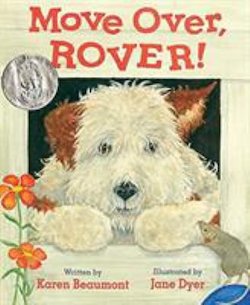
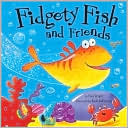 Early Literacy Aside--Explain: Today we are focusing on phonological awareness, the early literacy skill that includes rhyming and helps children hear parts of words. This activity will help children later sound out words as they learn to read.Early Literacy Aside--Example: This story, Fidgety Fish by Ruth Galloway, has rhyming and non-rhyming segments. We'll see words that rhyme and words that don't. Rhyming breaks words into smaller parts. Words that sound like the sounds they make also support phonological awareness. This is called onomatopoeia.
Early Literacy Aside--Explain: Today we are focusing on phonological awareness, the early literacy skill that includes rhyming and helps children hear parts of words. This activity will help children later sound out words as they learn to read.Early Literacy Aside--Example: This story, Fidgety Fish by Ruth Galloway, has rhyming and non-rhyming segments. We'll see words that rhyme and words that don't. Rhyming breaks words into smaller parts. Words that sound like the sounds they make also support phonological awareness. This is called onomatopoeia.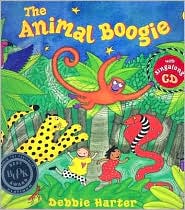 Early Literacy Aside--Explain: Researchers have found that one of the early literacy skills is phonological awareness. This is the ability to hear and play with the smaller sounds in words, like rhyming and hearing the beginning sounds of words. Today I'll be pointing out ways you can help your children with this skill.Early Literacy Aside--Example: Our next book is one we can sing. Listen to all the rhymes in this book. Singing slows down language and rhyming breaks down words into parts. Both of these help your children hear the smaller sounds in words. You can also think of other words that rhyme, or add extra verses at the end.
Read the book Animal Boogie by Debbie Harter.
Early Literacy Aside--Explain: Researchers have found that one of the early literacy skills is phonological awareness. This is the ability to hear and play with the smaller sounds in words, like rhyming and hearing the beginning sounds of words. Today I'll be pointing out ways you can help your children with this skill.Early Literacy Aside--Example: Our next book is one we can sing. Listen to all the rhymes in this book. Singing slows down language and rhyming breaks down words into parts. Both of these help your children hear the smaller sounds in words. You can also think of other words that rhyme, or add extra verses at the end.
Read the book Animal Boogie by Debbie Harter. Early Literacy Aside--Empower: Rhymes help teach "phonological awareness," an awareness of the sounds that make up words. You may have noticed that your child enjoys the way a nursery rhyme sounds even if it doesn't make much sense to him. When you introduce a new rhyme or song, repeat it at least twice. Three times is even better. And be sure to keep repeating the old, familiar rhymes too.
Submitted by Cindy Christin, Bozeman (MT) Public Library
Early Literacy Aside--Empower: Rhymes help teach "phonological awareness," an awareness of the sounds that make up words. You may have noticed that your child enjoys the way a nursery rhyme sounds even if it doesn't make much sense to him. When you introduce a new rhyme or song, repeat it at least twice. Three times is even better. And be sure to keep repeating the old, familiar rhymes too.
Submitted by Cindy Christin, Bozeman (MT) Public Library Early Literacy Aside--Explain: Singing songs is one good way for children to become aware of the different sounds that make up words. We call this phonological awareness. Singng helps them get a feel for the rhythm of language and how words are divided into syllables because there is a different note for each syllable. This will help them sound out words when they learn to read.
Submitted by Cindy Christin, Bozeman (MT) Public Library
Early Literacy Aside--Explain: Singing songs is one good way for children to become aware of the different sounds that make up words. We call this phonological awareness. Singng helps them get a feel for the rhythm of language and how words are divided into syllables because there is a different note for each syllable. This will help them sound out words when they learn to read.
Submitted by Cindy Christin, Bozeman (MT) Public Library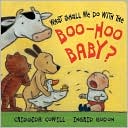 Early Literacy Aside--Explain: I will be having the children hear and make animal sounds. This is one of the ways to develop phonological awareness, hearing the smaller sounds in words. This is the beginning step to later sounding out words when they learn to read.Book Introduction: Our next book is What Shall We Do with teh Boo-Hoo Baby? by Cressida Cowell. All join in together with the animal sounds and the crying baby! [If you want you can practice the animal sounds and the boo-hoo for crying before starting the book.]
Read the book.
Early Literacy Aside--Example: Good job everyone. Parents, letting the children hear and make the sounds helps them later hear the sounds in words.
Early Literacy Aside--Empower: Feel free to check out these books I have displayed which have animal and other sounds, which will help with phonological awareness.
Early Literacy Aside--Explain: I will be having the children hear and make animal sounds. This is one of the ways to develop phonological awareness, hearing the smaller sounds in words. This is the beginning step to later sounding out words when they learn to read.Book Introduction: Our next book is What Shall We Do with teh Boo-Hoo Baby? by Cressida Cowell. All join in together with the animal sounds and the crying baby! [If you want you can practice the animal sounds and the boo-hoo for crying before starting the book.]
Read the book.
Early Literacy Aside--Example: Good job everyone. Parents, letting the children hear and make the sounds helps them later hear the sounds in words.
Early Literacy Aside--Empower: Feel free to check out these books I have displayed which have animal and other sounds, which will help with phonological awareness.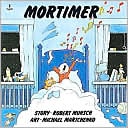 Gonna make my noise all day.
Clang, clang, rattle-bing-bang
Gonna make my noise all day.
You pass out musical instruments and have them play to the rhythm of the song.
Early Literaacy Aside--Example: As the children are saying the words of the sounds, they are developing phonological awareness.
Having them play to the rhythm of the words also helps develop this skill which will later help them sound out words when they learn to read.
Gonna make my noise all day.
Clang, clang, rattle-bing-bang
Gonna make my noise all day.
You pass out musical instruments and have them play to the rhythm of the song.
Early Literaacy Aside--Example: As the children are saying the words of the sounds, they are developing phonological awareness.
Having them play to the rhythm of the words also helps develop this skill which will later help them sound out words when they learn to read. Early Literacy Aside--Explain: Songs are a great way to incorporate the early literacy skill, phonological awareness. Hearing and learning animal sounds helps your children hear the smaller sounds in words and singing emphasizes different syllables. This helps your children later to sound out words.
Submitted by Wendy B. Rancier, Roanoke County (VA) Public Library
Early Literacy Aside--Explain: Songs are a great way to incorporate the early literacy skill, phonological awareness. Hearing and learning animal sounds helps your children hear the smaller sounds in words and singing emphasizes different syllables. This helps your children later to sound out words.
Submitted by Wendy B. Rancier, Roanoke County (VA) Public Library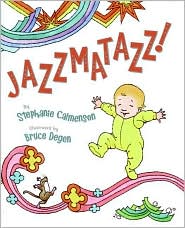 Early Literacy Aside--Example: What a fun and noisy book this is! Listen to the different kinds of sounds that music can make like plink, plink and bang-a-bang along with the jazz rhythm of Doo-dat, diddy-dat, diddy-dat, doo! As children learn to hear and make not only animal sounds but sounds of many different things, they are developing phonological awareness which will later help them sound out words as they learn to read.
Early Literacy Aside--Example: What a fun and noisy book this is! Listen to the different kinds of sounds that music can make like plink, plink and bang-a-bang along with the jazz rhythm of Doo-dat, diddy-dat, diddy-dat, doo! As children learn to hear and make not only animal sounds but sounds of many different things, they are developing phonological awareness which will later help them sound out words as they learn to read. During several consecutive storytimes you would choose a song to sing every time. For example, I chose Row Your Boat.In each storytime we sing the song correctly:
Row, row, row your boat; gently down the stream
Merrily, merrily, merrily, merrily; life is but a dream.
Then we sing the song again in a silly way, changing the first sound of each word:
Bow, bow, bow, bour boat, bently, bown be bream
Berrily, berrily, berrily, berrily; bife bis but ba bream.
Then we sing it again correctly.
Early Literacy Aside--Example: Singing nonsense songs like this help children hear the smaller sounds in words, in a fun way! Try it with different songs. Being able to change the first sound in a word is part of phonological awareness.
During several consecutive storytimes you would choose a song to sing every time. For example, I chose Row Your Boat.In each storytime we sing the song correctly:
Row, row, row your boat; gently down the stream
Merrily, merrily, merrily, merrily; life is but a dream.
Then we sing the song again in a silly way, changing the first sound of each word:
Bow, bow, bow, bour boat, bently, bown be bream
Berrily, berrily, berrily, berrily; bife bis but ba bream.
Then we sing it again correctly.
Early Literacy Aside--Example: Singing nonsense songs like this help children hear the smaller sounds in words, in a fun way! Try it with different songs. Being able to change the first sound in a word is part of phonological awareness. Super Duper 1, 2, 3
Can you say this word (or name) with me?
[volcano--or word/name of your choice]
Say it (You say it)
[Children/adults repeat the word with you]
Clap it (You clap it) (Say it again and clap it)
[Children/adults clap the word with you, one clap per syllable]
Snap it [snap fingers] (Say it again and snap it)
[Children/adults snap fingers together with you, one snap per syllable]
Tap it [tap with foot or tap knees] (Say it again and tap)
[Children/adults tap feet (or knees) with you, one tap per syllable]
Early Literacy Aside–Example: You can do this little song with any word! Dividing words into sound parts, into syllables, helps children hear the smaller sounds in words, one part of phonological awareness, the ability to hear the smaller sounds in words.
Super Duper 1, 2, 3
Can you say this word (or name) with me?
[volcano--or word/name of your choice]
Say it (You say it)
[Children/adults repeat the word with you]
Clap it (You clap it) (Say it again and clap it)
[Children/adults clap the word with you, one clap per syllable]
Snap it [snap fingers] (Say it again and snap it)
[Children/adults snap fingers together with you, one snap per syllable]
Tap it [tap with foot or tap knees] (Say it again and tap)
[Children/adults tap feet (or knees) with you, one tap per syllable]
Early Literacy Aside–Example: You can do this little song with any word! Dividing words into sound parts, into syllables, helps children hear the smaller sounds in words, one part of phonological awareness, the ability to hear the smaller sounds in words.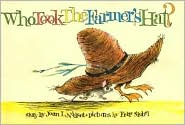 Read the book Who Took the Farmer's Hat? by Joan Nodset.
Read the book Who Took the Farmer's Hat? by Joan Nodset. 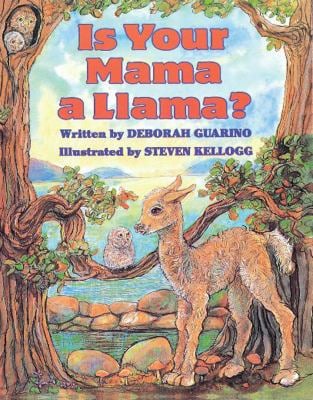
 Fingerplay:Stir a bowl of gingerbread (pretend to stir)
Smooth and spicy brown
Roll it with a rolling pin (pretend to roll dough)
Up and up and down
With a cookie cutter (imitate)
Make some little men
Put them in the oven (imitate)
'Til half past ten! (pretend to look at watch)
Early Literacy Aside--Example: Rhyming is one way that children learn to hear the smaller parts of words, also called phonological awareness. Talking about the words that rhyme as you say rhymes with your children will better prepare them to read when they begin to sound out words in school. Adding motions makes it more fun!
Fingerplay:Stir a bowl of gingerbread (pretend to stir)
Smooth and spicy brown
Roll it with a rolling pin (pretend to roll dough)
Up and up and down
With a cookie cutter (imitate)
Make some little men
Put them in the oven (imitate)
'Til half past ten! (pretend to look at watch)
Early Literacy Aside--Example: Rhyming is one way that children learn to hear the smaller parts of words, also called phonological awareness. Talking about the words that rhyme as you say rhymes with your children will better prepare them to read when they begin to sound out words in school. Adding motions makes it more fun!